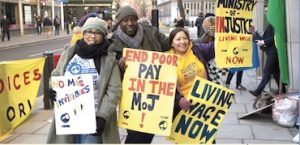On its 150th anniversary, the Paris Commune inspired many books, articles and conferences, and still inspires many struggles around the world. It claimed to be a universal republic, and the word “socialism” was widely used. But the socialism of the Communards, though rather confused programmatically and debated, bore no resemblance to what later became known as the dull, repressive and bureaucratic “real socialism”.
After nearly twenty years under the tyranny of Napoleon III, initiated by the coup d’état of 1851, of authoritarianism in the service of strong capitalist development, and the corruption that went with it, the Bonapartist Empire collapsed in its militaristic headlong rush against Prussia, on 4 September 1870, after a war lasting only a few weeks. The republic was declared. But which republic? The people of Paris, ardently republican (as well as those of the big cities) were going to live through a Prussian siege lasting several months, which meant deprivation, famine, an economy at a standstill and the polar cold of a very harsh winter, often without heating. The republican government, known as the Government of National Defence, gradually revealed its anti-popular and bourgeois nature, and its deceptive title: not believing in military victory, it was in fact seeking an agreement with Chancellor Bismarck, whose troops occupied a large part of the country. Finally, on 28 January, the ‘defenders’ signed an armistice with what had meanwhile become the German Empire, which demanded, among other things, 5 billion gold francs, the annexation of Alsace-Moselle, and the organisation of elections in France to validate a peace treaty on this basis. These elections were held on 8 February 1871, and resulted in a new assembly with a large reactionary majority (mainly royalist), ready for peace with Germany at any price. But the people of Paris had only endured this ruthless siege on two conditions: to fight the Prussian invaders to the bitter end, and to do so within a republican framework. They had been betrayed.
The new government, led by M. Thiers, multiplied the provocations against the people of Paris, in particular by deciding to install the national assembly in Versailles – the city of kings – and by letting Bismarck’s troops parade through western Paris from the 1st to the 3rd of March. With the so-called “Rural” assembly elected on 8 February, the attacks on the Parisian working classes were immediately very brutal. But they had the means to defend themselves: in the revolutionary tradition, a National Guard of some 300,000 men had been set up, reflecting the social composition of the then predominantly working-class Paris. This popular militia, which was overwhelmingly republican, anti-clerical and often socialist, had formed a federation and, within a few weeks, had a democratic decision-making structure, elected by the rank and file and revocable at any time, culminating in a Central Committee. The latter brought together national guards (soldiers and officers) from all over the city. This dual power represented a threat to the ruling classes and to the plans of Thiers and his reactionary assembly. Paris, a city of about two million souls, had then in its active population about 500,000 male and female industrial workers (half of them in the garment and art trades, a tenth in the building trade), to which were added about 120,000 employees, 100,000 servants and 140,000 bosses. But more than 60% of the latter worked alone or with one worker. Large companies were still rare: only two in Paris (in the metal industry) had more than a thousand employees. A large number of manual occupations, both male and female, sometimes highly qualified, occupied the working population present in the National Guard. The Parisian working world was scattered in a myriad of very small workshops, where bosses and employees were still very close.
Thiers wanted to solve this problem before the installation of the Assembly in Versailles, scheduled for 20 March. The Federals (the self-organised Parisian National Guard) had bought cannons by subscription, and had them under cover from Bismarck’s troops, on the heights of Montmartre and in eastern Paris. On the night of 17 to 18 March, Thiers ordered the recovery of these cannons, and sent some 15,000 men of the regular troops, who were also responsible for arresting the “leaders” who supported a commune in Paris. But the operation turned out very badly for Thiers: the carriages that were to transport the cannons did not arrive at Montmartre; at dawn, the people of the district (mainly women) had gathered and, having understood what was at stake, wanted to stop the operation. The fraternisation between the soldiers and the people of Montmartre took place: General Lecomte, ordering to fire on the crowd, was arrested and then executed by angry soldiers, like his colleague Clément-Thomas. People fraternised elsewhere in Paris, and within a few hours the masses had taken control of the streets and avenues and erected barricades. In the evening, the Central Committee of the National Guard seized the Hôtel de Ville (City Hall), which had been deserted: in the afternoon, Thiers had given orders to his ministers and his administrations to leave Paris and settle in Versailles. This 18 March marked the beginning of a revolution that was to last 72 days: nothing had been planned, the people, pushed to the limit and attacked, simply refused Thiers’ attack, fraternised with the soldiers, and in an immense and joyful uprising, reduced the bourgeois army present on the spot to shreds. Greatness of the spontaneity of the working masses!
On 19 March, the Central Committee decided to hand over the power it had just inherited to an elected Commune. After negotiations with the mayors and deputies of Paris already in place, the vote was held on March 26, and the Commune was proclaimed on March 28. Until 24 May, the Commune functioned as a political body whose members (many of them workers, but also other common people or known defenders of the people), elected and revocable, receiving incomes limited by the Commune itself to those of an average worker, directed Paris, in connection with the neighbourhood clubs, the committees of republican vigilance of the arrondissements (districts), and other popular bodies. Women, who did not have the right to vote at the time, were heavily involved in the action, particularly in the clubs and in the Women’s Union for the Defence of Paris and support for the wounded.
The work of the Commune, as Marx explained, lies first of all in its very existence: it remains an example of what we would call today self-organisation, a model of democracy from below, by and for the working people. In this short period, the Commune decided on emergency measures for the latter, others aimed at the longer term: extension of the remission of rents and bills of exchange that had fallen due; reactivation of public services abandoned by Thiers, such as the post office; prohibition of night work for bakery workers; reopening under workers’ cooperative management of workshops abandoned by their owners; suppression of the police and the permanent army and attribution of these functions to the National Guard; separation of the Church and the State; project of free, secular, obligatory and integral instruction (at the same time manual and intellectual) for all the children, boys and girls; wage equality between men and women in education…
But the Communards, overwhelmed with tasks, were very quickly confronted with military problems: in Versailles, Thiers managed to rebuild a disciplined army, removing it from the influence of the Commune and integrating soldiers from the provinces and prisoners released by the German army. After a month and a half of punctual attacks and increasing bombardments against Paris, the Versailles troops entered on 21 May. Until the 28th, the Bloody Week would see the crushing of the Commune. Some 15,000 or 20,000 National Guardsmen still on duty and the heroic people of Paris, entrenched behind multiple barricades, were gradually confined to a rapidly shrinking territory to the north-east of the city, and could not resist the 130,000 Versailles line troops, led by generals determined to finish off the insurgent “rabble”. It was a nameless slaughter, summary executions, and a number of Parisians killed that is still very much debated: 20,000 dead is an often quoted figure. Several thousand people were judged by the Councils of War, sent to a penal colony, especially in New Caledonia, or forced into exile, mainly in the United Kingdom and Switzerland. Thiers and the property-owning classes, initially panicked, had achieved their aim: to inflict, in the most barbaric way, a defeat on the working people of Paris, and to re-establish the bourgeois order which had been so seriously threatened. The Commune remains an example for workers and people all over the world: an example of heroism, of solidarity, of spontaneous creativity, of struggle for freedom and equality. The insurrection of 18 March 1871 and its immediate aftermath show that the working masses are the subject of great historical moments when the old world can be turned upside down. But the terrible defeat of the Commune is also rich in lessons. The insurgents did not try to pursue Thiers and his ministers in flight to Versailles when they were most vulnerable; they were quickly able to reorganise and counter-attack there. The Commune did not want to seize the Banque de France, which remained in Paris, and let finance the reaction and the Versailles butchery. Many illusions existed, and fundamental strategic debates had not yet taken place among the various Communard forces, which were otherwise divided. The Commune lacked a real revolutionary party, both a party for action and a party of memory, which would have learned the lessons of past historical experiences.




